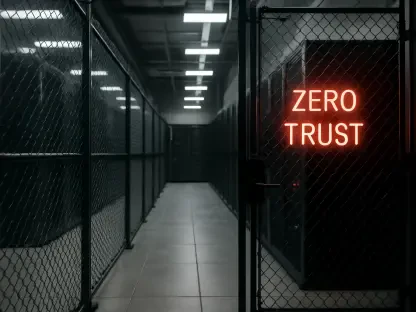Six months after the EU’s Digital Operational Resilience Act (DORA) became enforceable on January 17, a staggering 96% of financial firms across Europe confess they’re nowhere near meeting its rigorous standards, raising a pressing question about why so many institutions struggle to adapt. This alarming statistic highlights a regulation meant to safeguard the continent’s financial backbone against digital threats, yet a complex web of operational hurdles, financial constraints, and regulatory intricacies has left the sector scrambling to catch up.
The importance of this issue cannot be overstated. DORA isn’t just another checkbox for compliance; it represents a seismic shift in how banks, insurance companies, investment firms, and their IT providers must protect themselves against cyber risks. With potential fines reaching up to 2% of global annual turnover or €10 million ($11.6 million), the stakes are sky-high. Beyond monetary penalties, non-compliance risks undermining the stability of Europe’s financial ecosystem at a time when digital attacks are becoming more frequent and sophisticated.
Why Are Financial Firms Falling Behind on DORA?
The scale of non-compliance is jarring, with nearly all surveyed firms—96% to be exact—admitting their data resilience measures fall short of DORA’s expectations. This isn’t a minor oversight; it reflects a systemic challenge across an industry that spans multiple countries and complex operations. Many institutions, despite their size and resources, have found themselves unprepared for the depth of change required to align with this regulation.
A closer look reveals that the struggle isn’t just about awareness but about execution. Based on insights from a survey of 404 senior IT decision-makers and compliance heads from firms with over 500 employees across key European markets like the UK, France, Germany, and the Netherlands, the gap between intent and action is wide. The regulation’s comprehensive scope, covering everything from incident reporting to third-party oversight, has caught many off guard, exposing deep-rooted vulnerabilities in current systems.
The High Stakes of DORA for Financial Stability
DORA stands as a landmark regulation, crafted to fortify the cyber resilience of Europe’s financial sector. It targets a broad spectrum of entities, including banks, insurers, investment firms, and even their third-party IT providers, mandating stringent measures to withstand digital disruptions. The goal is clear: ensure that the financial system can endure and recover from cyber incidents without collapsing under pressure.
Failure to comply carries consequences far beyond regulatory slap-on-the-wrist fines. Penalties can climb to €10 million or 2% of a firm’s global annual turnover—whichever is higher—while third-party providers face daily fines up to 1% of their average global turnover for up to six months. These financial hits, combined with potential reputational damage, signal a harsh reality for firms that underestimate the regulation’s reach.
More critically, the broader implication looms large. Non-compliance could weaken the interconnected web of Europe’s financial infrastructure, making it a prime target for cyberattacks. As digital threats evolve, DORA serves as a critical reminder that resilience isn’t optional—it’s essential for maintaining public trust and economic stability.
Key Obstacles Blocking DORA Compliance
Delving into the specific barriers, third-party risk management emerges as the most daunting challenge, with 34% of surveyed firms citing it as their top struggle. A significant 20% lack any compliant oversight in this area, largely due to the intricate vendor networks that underpin financial operations. Managing these external relationships under DORA’s strict guidelines has proven to be a logistical nightmare for many.
Other critical areas lag far behind as well. Only 21-24% of firms have implemented necessary components like recovery testing, incident reporting, digital resilience testing, and secure data backup. These gaps highlight a troubling lack of readiness in fundamental aspects of operational resilience, leaving firms exposed to both regulatory scrutiny and real-world risks.
Operational strain compounds the issue. A notable 41% of companies report heightened stress on IT and security teams, while 37% face escalating costs from vendors adapting to DORA demands. Additionally, 20% of firms admit they haven’t secured the budget needed to meet compliance, pointing to financial limitations as a persistent roadblock in this transformative process.
Industry Perspectives on DORA’s Challenges
Voices from the sector paint a vivid picture of both frustration and cautious optimism. Andre Troskie, Field CISO EMEA at Veeam, notes a silver lining amid the chaos: 94% of firms now prioritize DORA more than ever, with many weaving its requirements into wider resilience strategies. This shift indicates a growing recognition of the regulation’s long-term value, even if the path to compliance remains rocky.
Yet, dissatisfaction simmers beneath the surface. Around 22% of respondents express discontent with DORA’s complexity, arguing for simpler rules and clearer guidance on managing third-party risks. Their feedback underscores a broader sentiment that while the regulation’s intent is sound, its design and implementation demands often feel overwhelming for teams already stretched thin.
These mixed reactions reflect an industry in flux. For every firm making strides toward compliance, others grapple with the sheer scale of changes required. The diversity of experiences—from proactive adaptation to outright struggle—illustrates the uneven terrain financial institutions must navigate in this new regulatory landscape.
Practical Strategies to Achieve DORA Alignment
Tackling DORA’s challenges requires a focused, actionable approach. First, firms must strengthen third-party oversight by establishing robust vendor assessment frameworks and conducting regular audits. Addressing the 34% who struggle with this area means prioritizing transparency and accountability across supply chains to mitigate hidden risks.
Securing adequate resources is another vital step. With 20% of companies lacking the necessary budget, gaining executive buy-in is crucial. Aligning DORA objectives with broader business goals can help justify dedicated funding, ensuring that compliance efforts aren’t derailed by financial shortfalls. This strategic alignment can turn a regulatory burden into a competitive advantage.
Finally, closing implementation gaps demands urgency. Firms should schedule regular continuity tests and streamline incident reporting to address the low 21-24% adoption rates in these areas. Leveraging industry best practices and seeking regulatory clarifications can also simplify DORA’s framework, responding to the 22% who call for better design and support. These steps, though demanding, pave a clearer path toward resilience.
Reflecting on a Sector in Transition
Looking back, the journey of Europe’s financial firms with DORA reveals a landscape marked by widespread struggle yet punctuated by gradual progress. Six months into enforcement, the pervasive 96% non-compliance rate underscores deep systemic challenges, from third-party risk management to operational strain. Despite these hurdles, the shift in organizational priorities, with 94% of firms elevating DORA’s importance, signals a turning point in how the sector views digital resilience.
The road ahead demands actionable commitment. Firms need to invest in robust vendor oversight, secure dedicated budgets, and prioritize testing and reporting frameworks to close critical gaps. Collaboration with regulators for clearer guidelines also emerges as a necessary step to ease the burden of complexity. These efforts, if sustained, promise to transform compliance from a daunting obligation into a cornerstone of stability.
Ultimately, the story of DORA’s early impact highlights a sector at a crossroads. The next few years, from 2025 to 2027, will test whether financial institutions can bridge the divide between current shortcomings and the regulation’s ambitious vision. Embracing strategic partnerships and innovative solutions offers a way forward, ensuring that resilience becomes not just a mandate, but a lasting strength.









